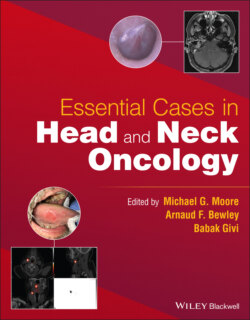Читать книгу Essential Cases in Head and Neck Oncology - Группа авторов - Страница 81
Management
ОглавлениеQuestion: Which of the following steps would be appropriate?
Flexible fiberoptic nasopharyngoscopy: yes/no. This is appropriate for full evaluation of nasopharynx (given prior history) and to examine the inferior extent of lesion in the right tonsil and rule out other lesions in larynx or hypopharynx.In this patient, exam showed no lesions in nasopharynx with a patent fossa of Rosenmuller bilaterally and radiation changes of the pharynx.
Tonsil biopsy in office: yes/no. This is appropriate since a visible lesion is apparent and is accessible for office biopsy.Pathology demonstrated invasive well‐differentiated SCC. Stains for p16 on immunohistochemistry were negative.
CT neck with contrast or MRI neck with contrast: yes/no. Kidney function may not permit administration of contrast, and, in general, MRI can be performed in patients with lower GFR who may not tolerate the contrast required for a CT.This patient was found to have normal kidney function with estimated GFR = 90 and so a CT of the neck with contrast is obtained (see Figure 11.1).
FIGURE 11.1 A CT of the neck was performed with intravenous contrast. There is a 1.5 cm right tonsil primary tumor with normal fat plane observed in the right parapharyngeal space. Left submandibular gland is not visualized. Right submandibular gland is small. There is no pathologic lymphadenopathy.
PET scan: yes/no. PET scan is appropriate in staging head and neck cancer and to identify distant disease and possibly second primaries (see Figure 11.2). This is particularly important in patients with a history of smoking >40 pack‐years who have significant risk of lung primaries. CT chest with contrast may also be obtained. Consideration should be given to renal function when additional contrast is given for a CT chest shortly after administration of contrast for a CT neck.
Question: Based on your assessment, what would be this patient's clinical staging?
Answer: HPV‐ oropharynx T1N0M0. It is an oropharynx primary since the lesion is in the tonsil. The nasopharynx is clear and the history is so remote that recurrence is not likely. Given her history of tobacco use, prior mucosal primary and lack of concurrent adenopathy, her tumor is most likely not HPV‐associated. A p16 immunohistochemical stain was performed as a surrogate marker for HPV, and the tumor cells did not stain. The oropharynx subsite has a sized‐based staging system for the primary tumor. Since it is less than 2 cm, it is a T1 lesion.
FIGURE 11.2 This is an axial cut of the patient's PET/CT. There is slight soft tissue thickening of the right tonsillar pillar with a maximal SUV of 2.6. The SUV of the left tonsil bed is 2.3. No lymphadenopathy is noted.
Question: What is the next appropriate step in her management?
Answer: Multidisciplinary consultation and/or tumor board. It is always a good idea to obtain multidisciplinary input especially when there are several treatment options. This patient's case of a cT1N0M0 right tonsil cancer was reviewed at the institution's Multidisciplinary tumor board. Due to her prior radiation treatment for nasopharyngeal cancer, consensus opinion was that therapeutic dose of reirradiation could not be given because of concern over overlapping fields and increased toxicity. Surgery was therefore recommended.
Question. The decision is made to manage the patient with definitive surgical resection. What is the best surgical therapy to address the primary tumor?
Answer: Radical tonsillectomy with removal of the constrictor muscle lateral to the tumor. A simple tonsillectomy is not an oncologic operation and should not be performed in the presence of a known malignancy. The goal is to obtain margins of normal tissue around the tumor. The deep margin is the most challenging in the oropharynx because the constrictor muscle itself can be <5 mm. A radical tonsillectomy includes resection of the underlying superior constrictor muscle. In this radiated patient, if the lesion is superficial, it may be advisable to maintain the deep aspect of the muscle or fascia to optimize healing and minimize the risk to the adjacent neck vessels. If the patient is at high risk for carotid exposure from the resection, reconstruction with a regional tissue or a free flap should be considered.
Question: How should the neck be treated in this patient?
Answer: An ipsilateral selective neck dissection should be performed. The risk of neck metastasis is still significant for a small primary such as this. As mentioned before, reirradiation is not advisable due to the risk to the carotid artery and spinal cord. Contralateral neck dissection is not necessary because risk of contralateral metastases in tonsil cancer is very low when there are no metastases seen in the ipsilateral neck.
The patient undergoes surgery: transoral partial pharyngectomy and right selective neck dissection – levels I–IV (see Figure 11.3).
Question: Based on the pathological findings, what additional treatment would you recommend?
Answer: Close observation. In general, margins greater than 5 mm are considered ideal. However, in the tonsillar fossa it may be hard to achieve greater than 5 mm. This patient now has a history of two head and neck cancers and mucosal dysplasia associated with a second primary. She should have close clinical follow‐up.
FIGURE 11.3 This intraoperative photo shows the resection bed following a robotic right‐sided radical tonsillectomy. Pathology reveals no tumor identified in 25 lymph nodes (0/25). The primary tumor is a 1.2 cm well‐ to moderately differentiated SCC. All margins free of cancer by at least 5 mm. Reconstruction of intraoral soft palate defect is performed with a pedicled buccal fat flap.
